News Brief
Delhi-Varanasi Bullet Train: Fares To Be Between Rs 1,200-Rs 3,400; High-Speed Corridor To Have 11 Stations
- The indicative fares of the Delhi-Varanasi High Speed Corridor are ranging between 1.3 to 1.5 times of the Executive Class fares running in the sections

JR East E5 series shinkansen set U3 approaching Omiya Station on the “Hayabusa 4” service to Tokyo . (Wikipedia)
It would cost Rs 1,200 for Agra and Rs 3,400 for Varanasi from the national capital in the Delhi-Varanasi bullet train as the detailed project report (DPR) of the proposed high speed corridor has suggested.
The DPR prepared by the National High Speed Rail Corporation has kept the train fare for Lucknow at Rs 2,300 and Rs 2,900 for Ayodhya.
The DPR submitted to the Railways has also estimated that it would cost Rs 265 crore per km to construct the 865 km long Delhi-Varanasi High Speed Corridor which includes the rolling stock procurement cost also.
"The train fares for various destinations suggested in the DPR are indicative in nature and not final. There could be changes in the fare structure in the later stage," sources in the Railways said.
Aiming at reducing travelling time between major cities, the high speed corridors are being planned across the country.
There are various factors like project cost, paying capacity, type of patrons in the route are taken into account to decide the fare structure, sources added.
According to railways, the indicative fares of the Delhi-Varanasi High Speed Corridor are ranging between 1.3 to 1.5 times of the Executive Class fares running in the sections.
Ayodhya, the birthplace of Lord Ram, will get bullet train connectivity. The Delhi-Varanasi corridor for which the detailed project report (DPR) is being prepared will connect the holy city.
The project is using an advanced survey technique that combines laser data, GPS information, flight parameters, and real pictures.
Delhi-Varanasi route alignment will cover mixed terrains including densely populated urban and rural areas, highways, roads, ghats, rivers, green fields, which makes the construction more challenging.
NHSRCL, which is executing the Mumbai-Ahmedabad bullet train project, has deployed the Light Detection and Ranging Surve (LiDAR) technique using laser enabled equipment mounted on a helicopter for ground survey.
The alignment or ground survey is a critical activity for any linear infrastructure project as the survey provides details of areas around the alignment.
The proposed Delhi-Varanasi high-speed rail corridor via Ayodhya, to be built in 2026-30, will cost Rs 1,71,000 crore, according to estimates in the draft national rail plan document.
Introducing ElectionsHQ + 50 Ground Reports Project
The 2024 elections might seem easy to guess, but there are some important questions that shouldn't be missed.
Do freebies still sway voters? Do people prioritise infrastructure when voting? How will Punjab vote?
The answers to these questions provide great insights into where we, as a country, are headed in the years to come.
Swarajya is starting a project with an aim to do 50 solid ground stories and a smart commentary service on WhatsApp, a one-of-a-kind. We'd love your support during this election season.
Click below to contribute.
Latest